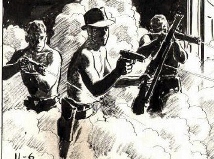IDW Adds SCORCHY SMITH Collection to Library of American Comics
The growing comic publisher's new hardcover book of the classic comic strip Scorchy Smith spotlights artist Noel Sickles, who helped shape 20th century illustration.
This July, IDW Publishing (Angel, Star Trek) will release a new collection of the entire mid-1930s Scorchy Smith comic strip run of influential artist Noel Sickles (1910-1982). The latest addition to The Library of American Comics, Scorchy Smith and the Art of Noel Sickles is a deluxe 394-page hardcover edited and designed by Eisner Award nominee Dean Mullaney (The Complete Terry and the Pirates).
 John Terry (brother of Terrytoons animator Paul Terry) launched Scorchy Smith in March 1930 to capitalize on the rising popularity of aviation caused by Charles Lindbergh's 1927 trans-Atlantic flight. The title character--who resembled "Lucky Lindy" in his blond, slim appearance--was a young pilot-for-hire who fought criminals, solved mysteries and aided damsels in distress, among other things, before turning to international espionage.
John Terry (brother of Terrytoons animator Paul Terry) launched Scorchy Smith in March 1930 to capitalize on the rising popularity of aviation caused by Charles Lindbergh's 1927 trans-Atlantic flight. The title character--who resembled "Lucky Lindy" in his blond, slim appearance--was a young pilot-for-hire who fought criminals, solved mysteries and aided damsels in distress, among other things, before turning to international espionage.
When Terry left due to tuberculosis in 1933, this typical adventure strip fell to relative unknown Noel Douglas Sickles.
The self-taught artist had been something of a teenage wunderkind, contributing political cartoons to the Ohio State Journal. On December 4, 1933, Scorchy Smith became one of his duties as an Associated Press staff artist. Despite his vocal dislike for the work of Terry, who was better at getting it out on time than at imbuing it with outstanding quality, Sickles dutifully copied the creator's style. However, he gradually was able to let his own way of doing it emerge.
Sickles used his three years as Scorchy's artist-scribe to stage a revolution in pen-&-ink cartooning. He distanced himself from the industry-predominant heavy black outlines, relying instead on brushwork to create a looser style that included a greater contrast of light and shade.
"Scorchy Smith became a primer from which a multitude of comic book and strip artists cribbed mercilessly for decades," noted writer-artist Jim Steranko (Nick Fury) in his introduction to the new collection.
 In the fall of 1936, Sickles researched Scorchy Smith’s circulation, without any help from the Associated Press. He estimated that the strip was running in 250 U.S. papers, and that AP’s monthly take approximated $2,500 a month, while Sickles received $125 as writer-artist. When his request for a raise was denied, he quit AP, Scorchy Smith and comic strips in general. Thus began a 40-year stint as one of America's premier magazine illustrators. Sickles won the National Cartoonist Society's Advertising and Illustration Award in 1960 and again in '62.
In the fall of 1936, Sickles researched Scorchy Smith’s circulation, without any help from the Associated Press. He estimated that the strip was running in 250 U.S. papers, and that AP’s monthly take approximated $2,500 a month, while Sickles received $125 as writer-artist. When his request for a raise was denied, he quit AP, Scorchy Smith and comic strips in general. Thus began a 40-year stint as one of America's premier magazine illustrators. Sickles won the National Cartoonist Society's Advertising and Illustration Award in 1960 and again in '62.
Scorchy flew with many other artistic co-pilots before finally landing in 1961. It's an event that CARROL VERTREES once bemoaned in his Chicago Post-Tribune column.
"I do not see anyone in the funny papers who helps damsels in distress, which is a shame, but, maybe in real life, damsels get helped all the time," Vertrees wrote. "That is only a guess, though."
Besides his complete 900-strip work on the title series, Scorchy Smith and the Art of Noel Sickles contains an astonishing 140 pages of Sickles's illustrations for stories by Ernest Hemingway, James A. Michener, Alexandr Solzhenitsyn and William Faulkner; the highly-detailed World War II drawings that made him such a valuable U.S. military commodity; and Bruce Canwell's original biographical essay on Sickles. Mullaney's original announcement about the project mentioned only 60 pages of additional art.
Scorchy Smith and the Art of Noel Sickles hits bookshelves on July 30, 2008.
[Thanks to HEIDI MACDONALD at PW's The Beat, Don Markstein's Toonopedia, Lambiek.net, Wikipedia and the team at ICv2.]